#mlalgorithms
Explore tagged Tumblr posts
Text
#LinearRegression#MachineLearning#DataScience#AI#DataAnalysis#StatisticalModeling#PredictiveAnalytics#RegressionAnalysis#MLAlgorithms#DataMining#Python#R#MATLAB#ScikitLearn#Statsmodels#TensorFlow#PyTorch
1 note
·
View note
Text
Machine Learning Algorithms for Beginners: A Simple Guide to Getting Started
Machine learning (ML) algorithms are powerful tools that allow computers to learn from data, identify patterns, and make decisions without explicit programming. These algorithms are categorized into three types: supervised learning, unsupervised learning, and reinforcement learning.
Supervised Learning involves training a model on labeled data, where each input has a corresponding output. Common algorithms in this category include linear regression (used for predicting continuous values), logistic regression (for binary classification), and decision trees (which split data based on certain criteria for classification or regression tasks).
Unsupervised Learning is used when there are no labels in the data. The algorithm tries to find hidden patterns or groupings. K-means clustering is a popular algorithm that divides data into clusters, while Principal Component Analysis (PCA) helps reduce data complexity by transforming features.
Reinforcement Learning is based on learning through interaction with an environment to maximize cumulative rewards. An example is Q-learning, where an agent learns which actions to take based on rewards and penalties.
Selecting the right algorithm depends on the problem you want to solve. For beginners, understanding these basic algorithms and experimenting with real-world data is key to mastering machine learning. As you practice, you’ll gain the skills to apply these algorithms effectively.
For deeper knowledge on machine learning algorithms, here is a blog where I learned more about these concepts.
#MachineLearning#MLAlgorithms#SupervisedLearning#UnsupervisedLearning#ReinforcementLearning#DataScience#AI#DataAnalysis#LinearRegression#LogisticRegression#DecisionTrees#KMeans#PCA#DataClustering#Qlearning#ArtificialIntelligence#DeepLearning#TechForBeginners#LearnMachineLearning#DataScienceForBeginners#AIinPractice
1 note
·
View note
Text
How Machine Learning is Revolutionizing Software Testing with GenQE

Machine learning in software testing is revolutionizing the field by automating and optimizing various testing activities. Traditional testing methods struggle with the fast-paced development cycles of modern software, but GenQE leverages machine learning (ML) to enhance efficiency and accuracy. ML algorithms analyze data, identify patterns, and prioritize test cases, making testing faster and more reliable. Key applications include regression testing, test automation, defect prediction, and anomaly detection. GenQE's ML capabilities lead to increased efficiency, improved test coverage, early bug detection, and optimized test execution. This results in higher software quality with fewer errors. As machine learning in software testing evolves, it will play an even more critical role in ensuring software reliability and excellence.
#genqe#machine learning#software testing#DefectPrediction#BugDetection#qualityassurance#mlalgorithms#softwarequality#TestingInnovation#OptimizeTesting
0 notes
Text
What skills are needed for machine learning jobs?
Machine learning jobs typically require a diverse set of skills, including:
1.Programming Languages: Working with data and implementing machine learning algorithms require proficiency in languages like Python, R, and occasionally Java or C++.
2. Mathematics and Statistics: To comprehend and create machine learning models, one must have a solid foundation in linear algebra, calculus, probability, and statistics.
3. Machine Learning Algorithms: Knowledge of various machine learning algorithms and techniques, including supervised and unsupervised learning, neural networks, and reinforcement learning.
4. Data Handling: To prepare data for analysis, one must be proficient in the preparation, cleaning, and manipulation of data using tools and libraries such as Pandas, NumPy, and SQL.
5. Data visualization: The capacity to analyze model performance and insights by visualizing data and results using tools and frameworks like Matplotlib, Seaborn, or Tableau.
6. Knowledge in ML Frameworks: Proficiency in building and training models using machine learning frameworks and libraries such as TensorFlow, PyTorch, Keras, or Scikit-learn.
7. Big Data Technologies: Proficiency in handling and processing massive datasets through the use of big data tools and platforms such as Hadoop, Spark, or cloud-based services (such AWS, Google Cloud, and Azure).
8. Software Engineering Skills: Competence in software development practices, including version control (e.g., Git), debugging, and writing clean, maintainable code. Strong problem-solving abilities and the capacity to approach challenging issues analytically in order to provide useful insights are required for analytical thinking and problem-solving.
9. Domain Knowledge: Developing appropriate models and comprehending context can be aided by having knowledge of the particular area or industry in which machine learning is being applied.
These skills combine to enable professionals to build, deploy, and refine machine learning models that drive data-driven decision-making and innovation.
#MachineLearning#DataScience#AI#Programming#Python#RLanguage#Statistics#DataAnalysis#BigData#TensorFlow#PyTorch#DataVisualization#MLAlgorithms#SoftwareEngineering#TechSkills
1 note
·
View note
Text
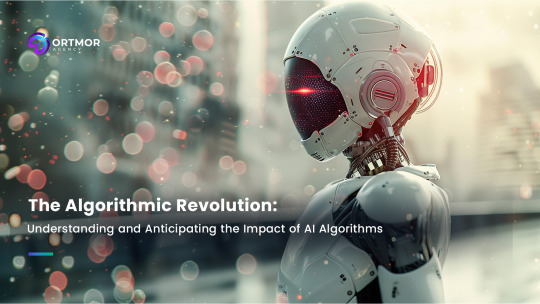
Discover the impact of AI algorithms and learn how these algorithms evolve and collaborate with humans, shaping a future amplified by technology.
#ortmoragency#deliveringdigitalhappiness#artificialintelligence#machinelearning#algorithm#mlalgorithms#deeplearning#AI#DataScience#neuralnetworks#NLP#computervision#bigdata#robotics#automation#predictiveanalytics#AIResearch#TechTrends#dataanalytics#ReinforcementLearning
0 notes
Text
Exploring the Latest Trends in Artificial Intelligence and Machine Learning
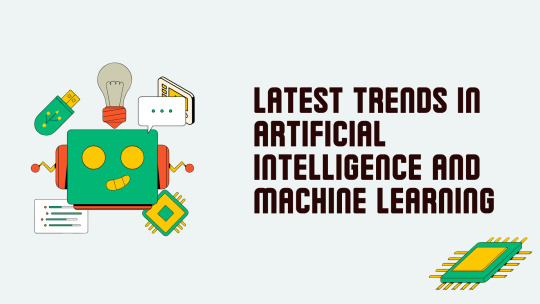
Introduction:
In recent years, the fields of Artificial Intelligence (AI) and Machine Learning (ML) have witnessed unprecedented growth and innovation. From breakthroughs in natural language processing to advancements in computer vision, the landscape of AI and ML is constantly evolving. In this blog, we'll delve into some of the latest trends shaping these fields and explore their implications for various industries and society at large.
1. Deep Learning and Neural Networks:
Deep learning, a subset of ML, continues to be at the forefront of AI research and development. With the advent of large-scale neural networks and powerful computing infrastructure, deep learning models have achieved remarkable success in tasks such as image recognition, speech recognition, and natural language understanding. Recent trends in deep learning include the development of more efficient architectures, such as transformers, and the exploration of self-supervised learning techniques, which reduce the reliance on labeled data.
2. Generative Models:
Generative models, which aim to generate new data samples from a given distribution, have gained significant attention in recent years. Variational Autoencoders (VAEs) and Generative Adversarial Networks (GANs) are two popular approaches in this domain. Applications of generative models range from creating realistic images and videos to generating synthetic data for training ML models and simulating complex environments for reinforcement learning.
3. Federated Learning:
Privacy concerns and the growing volume of sensitive data have spurred interest in federated learning, a decentralized approach to ML model training. In federated learning, models are trained locally on distributed devices or servers, and only the model updates, rather than raw data, are shared with a central server for aggregation. This enables collaborative learning across multiple parties while preserving data privacy and security, making it particularly relevant in healthcare, finance, and other industries with strict data regulations.
4. Explainable AI (XAI):
As AI systems are increasingly deployed in high-stakes domains such as healthcare and criminal justice, there is a growing demand for transparency and interpretability. Explainable AI (XAI) techniques aim to make AI models more transparent and understandable to humans by providing insights into how they make decisions. This not only enhances trust and accountability but also enables domain experts to identify biases and errors in the model's reasoning.
5. Edge AI:
Edge AI refers to the deployment of AI algorithms and models directly on edge devices, such as smartphones, IoT devices, and autonomous vehicles, rather than relying on cloud-based servers. This allows for real-time inference and decision-making without requiring constant internet connectivity, making it ideal for applications where low latency and privacy are critical, such as autonomous driving, industrial automation, and remote healthcare monitoring.
Conclusion:
The field of Artificial Intelligence and Machine Learning is characterized by rapid innovation and constant evolution. The trends discussed in this blog represent just a snapshot of the current landscape, and we can expect further breakthroughs and developments in the years to come. As AI and ML continue to permeate various aspects of our lives, it's essential to stay informed about the latest trends and their implications for society, ethics, and policy. By harnessing the power of AI and ML responsibly, we can unlock new opportunities and address some of the most pressing challenges facing humanity.
#ArtificialIntelligence#MachineLearning#AI#ML#TechTrends#Innovation#FutureTech#DataScience#DeepLearning#AIResearch#TechInnovation#AIApplications#MLAlgorithms#NeuralNetworks#AITrends
0 notes
Text
Understanding Machine Learning and Big Data in Today's World
Machine learning is a branch of artificial intelligence wherein computers make predictions based on patterns that they have directly observed from data, without the need for explicit programming. This definition makes clear that machine learning is a branch of artificial intelligence. Since terminology like machine learning algorithms, artificial intelligence, deep learning, and even data science are frequently used interchangeably, let’s take a closer look at definitions.
#MLAlgorithms#MachineLearning#AIML#DataScience#AIAlgorithms#DeepLearning#MLTech#MLResearch#AlgorithmicAI#MLInnovation
0 notes
Text
Machine Learning with Python

Master Machine Learning with Python: Embark on your journey into machine learning and learn how Python supercharges the field. Pen spark LSET's comprehensive guide offers hands-on tutorials and expert insights to help you grasp fundamental concepts and advanced techniques in machine learning. Plus, with London School of Emerging Technology (LSET) Machine Learning with Python Course, you'll receive specialised training and personalised mentorship to ensure you're well-equipped to tackle real-world machine learning projects. Join us and embark on a journey to become a skilled machine learning practitioner, ready to make meaningful contributions in the world of technology."
Enrol @ https://lset.uk/ for admission.
0 notes
Text
youtube
Session 16 : What is Reinforcement Learning | Explained: Key Concepts and Model Breakdown
Welcome to Session 16! 🚀 In this enlightening session, we dive deep into the fascinating world of Reinforcement Learning. 🤖 Get ready for a comprehensive exploration as we break down key concepts and unravel the mysteries behind Reinforcement Learning models.
youtube
Subscribe to "Learn And Grow Community" YouTube : https://www.youtube.com/@LearnAndGrowCommunity LinkedIn Group : https://linkedin.com/company/LearnAndGrowCommunity Follow #learnandgrowcommunity
#ReinforcementLearning#MachineLearning#AIExplained#mlmodels#deeplearninginsights#intelligenttechnology#aiinnovation#DataScience#smarttechsolutions#aibasics#RLApplications#cognitivecomputing#AlgorithmicIntelligence#futuretechtrends#aiprogress#learnai#techevolution#mlalgorithms#aiforeveryone#aiapplications#aicommunity#aiexplained#machinelearningbasics#machinelearningjourney#ml#learnandgrowcommunity#Youtube
1 note
·
View note
Text
MACHINE LEARNING
Machine Learning For Data Analytics
INTRODUCTION

HOW DOES MACHINE LEARNING WORK?
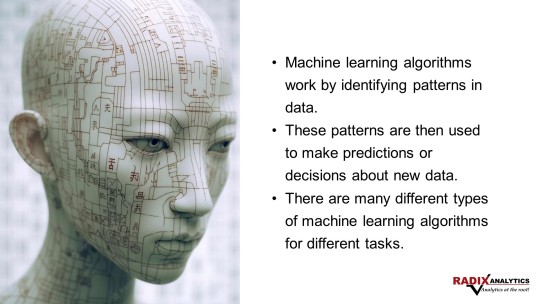
TYPES OF MACHINE LEARNING
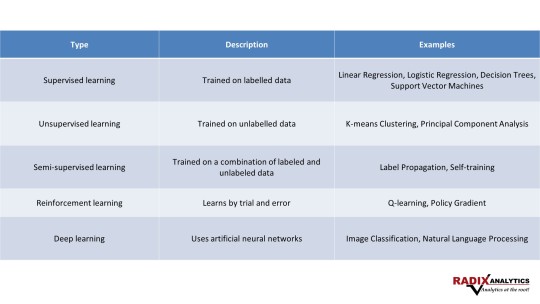
USES OF ML IN ANALYTICS
Identify patterns in data
Make predictions about future events
Cluster data into groups
Reduce the dimensionality of data
Improve the accuracy of data models
CHALLENGES OF ML IN ANALYTICS
It can be difficult to find and prepare the data that is needed to train the algorithms.
Machine Learning algorithms can be computationally expensive to train and run.
Some of the algorithms are difficult to interpret even though they work well.
FUTURE OF MACHINE LEARNING IN ANALYTICS
Machine learning is a rapidly evolving field, and there are many new developments in this area.
As machine learning algorithms become more powerful and efficient, they will be used for a wider range of data analytics tasks.
Machine learning will also be used to automate more tasks that are currently done manually.
#MachineLearning#ML#ArtificialIntelligence#AI#DataScience#DeepLearning#NeuralNetworks#Algorithm#DataMining#PredictiveModeling#BigData#ComputerVision#NaturalLanguageProcessing#PatternRecognition#AIinBusiness#MLAlgorithms#MLModels#MachineLearningEngineer#MLResearch#AIApplications
0 notes
Text
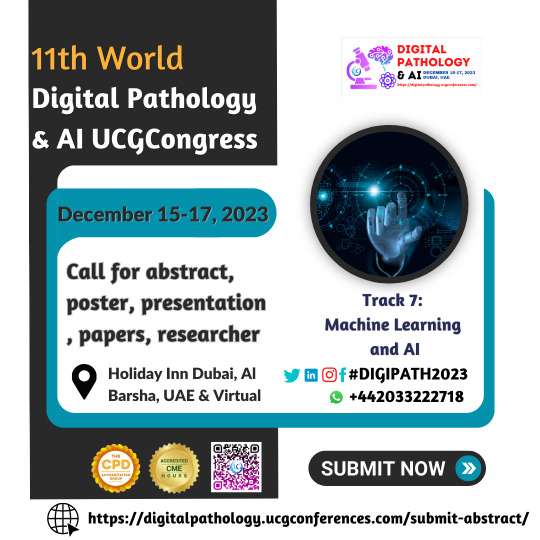
Call for abstract, poster, presentation, papers, researcher!!!! The CME/CPD accredited the 11th World Digital Pathology & AI UCGCongress from December 15–17, 2023 in Holiday Inn Dubai, Al Barsha, UAE & Virtual.
WhatsApp us: https://wa.me/442033222718?text= Submit your abstract here: https://digitalpathology.ucgconferences.com/submit-abstract/
#AIDevelopment#AICommunity#AIforGood#AIExpert#AIandHealthTech#AIandTechTrends#MachineLearning#ArtificialIntelligence#AI#DataScience#DeepLearning#NeuralNetworks#ComputerVision#NLP#BigData#NaturalLanguageProcessing#DataMining#MachineLearningModel#AIResearch#MLAlgorithms#TensorFlo
0 notes
Text
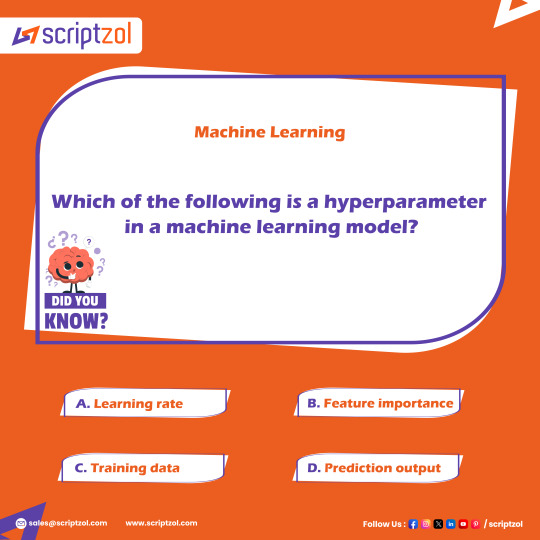
Which of the following is a hyperparameter in a machine learning model?
a. Learning rate b. Feature importance c. Training data d. Prediction output
#MachineLearning#MachineLearningquiz#MachineLearningPoll#followme#followforfollow#instadaily#follow4follow#like4like#letsconnect#scriptzol#MachineLearningBasics#HyperparameterTuning#AIInnovation#DataScience101#MLAlgorithm#TechInsights#AlgorithmOptimization#ModelTraining#AIKnowledge#DataDrivenDecisions
0 notes
Text
What is machine learning and how does it work?
Unlock the mysteries behind the technological marvel – discover "What is machine learning and how does it work?" in this comprehensive guide. Explore the intricacies of machine learning algorithms, their applications, and the underlying principles that power this transformative technology. Unravel the magic behind smart systems that learn and adapt without explicit programming.
Click here- https://medium.com/@yusufkhan.kvch/what-is-machine-learning-and-how-does-it-work-5ba8b1aa214f
#MachineLearning
#TechExplained
#HowMachineLearningWorks
#MLAlgorithms
#TechMagic
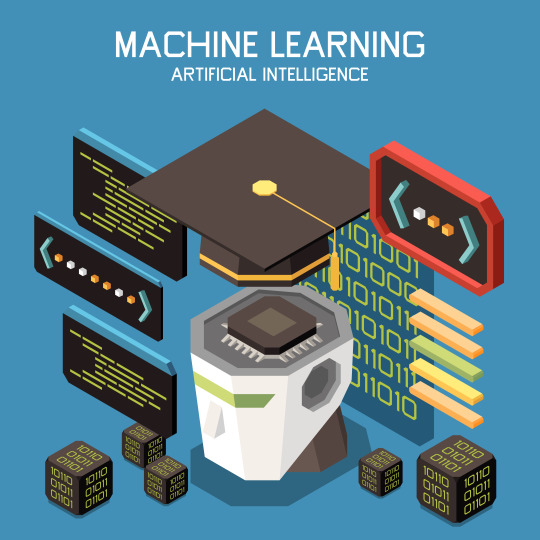
#Machine Learning Training Institute in Delhi#Machine Learning Course in Delhi#Best Machine Learning Training in Noida
0 notes
Text
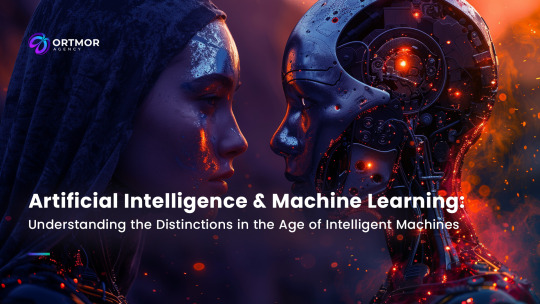
Explore the distinctions between artificial intelligence and machine learning, discover their combined potential, and envision the future possibilities AI and ML can unlock.
#ortmoragency#deliveringdigitalhappiness#AI#Future#machinelearning#deeplearning#artificialintelligence#neuralnetworks#aiforgood#mlalgorithms#automation#robotics#AIFuture#AIResearch#predictiveanalytics#smarttechnology#IntelligentSystems
0 notes
Photo

NextWealth helped to prepare data for ML algorithms, validated the output improving the accuracy of ML algorithms by 3x for an American Multinational Retail Corporation
0 notes
Text
youtube
Session 11 : What is Classification Task in Supervised machine Learning | Beginner-Friendly ML
Have you ever wondered how machines can be trained to make decisions, just like humans? Classification tasks play a crucial role in this process. Whether it's identifying spam emails, predicting diseases, or recognizing handwritten digits, classification allows machines to categorize data into distinct groups.
youtube
Subscribe to "Learn And Grow Community"
#machinelearning#machinelearningbasics#artificialintelligence#supervisedlearning#aiapplications#aiexplained#aicommunity#aiconcepts#mlexplained#ml#mlalgorithms#datascience#ClassificationTutorial#MLForBeginners#EasyML#HandsOnLearning#PredictiveModeling#ExploreWithML#TechDemystified#BeginnerFriendly#AIEducation#MLJourney#EmpowerYourKnowledge#LearnTech#DataClassification#SimpleML#AccessibleLearning#MLExplained#StartWithML#learnandgrowcommunity
1 note
·
View note